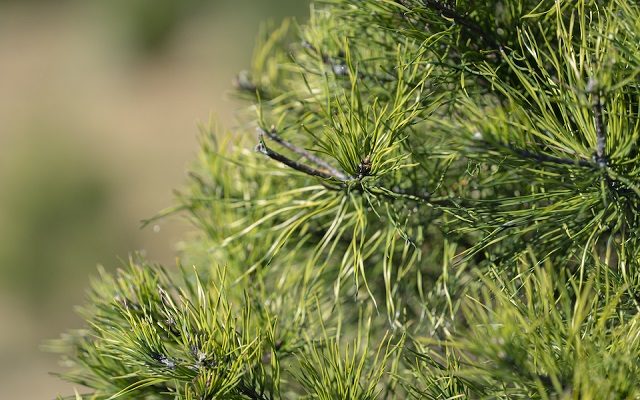Are there Benefits to Having a Real Christmas Tree?

Story Provided by Texas A&M AgriLife Extension and Research
While consumers have a choice between selecting a real Christmas tree or an artificial one, the Texas A&M Forest Service is shedding light on the benefits of the real tree.
An average of 20-25 million real Christmas trees are sold in the U.S. every year, or roughly one tree for every five households, according to Marsha Gray of the Christmas Tree Promotion Board. Nationally, the real Christmas tree industry also employs around 100,000 people.
“Christmas trees are grown in all 50 states,” said Gray. “But the top producing regions are centered around Oregon, North Carolina and Michigan.”
Trees from those areas are the ones you’re likely to find at retail lots, garden centers and your standard home improvement store. Nevertheless, many Americans prefer going to local Christmas tree farms, picking out their favorite tree, then carrying it back to their homes. And thanks to the hardiness of Christmas trees, Americans are able to do that almost everywhere throughout the U.S.
Real Christmas trees
While it might seem counterintuitive that cutting down a live tree would be beneficial, sustainably managed forests have immense environmental benefits.
Christmas trees are grown for an average of eight to 10 years before they are cut down, and more than 350 million trees are currently growing on Christmas tree farms throughout the U.S, with only a fraction of that number being harvested each year.
Beyond converting carbon dioxide into breathable oxygen, Christmas trees filter water, reduce runoff and potential flooding, and provide homes, food and protection for wildlife. They cool the average temperatures around them by almost 10 degrees, reduce erosion and pollution, as well as wood used to build homes and businesses.
Additionally, there are personal benefits of having a real Christmas tree in the home. From improving mental health, productivity and happiness to boosting your immune system and lowering anxiety, research has proven time and again that living plants and trees are invaluable.
And real trees are entirely biodegradable. Thousands of organizations will take the tree to convert it into mulch or composted soil when it is time to dispose of them.
Artificial Christmas trees
Some consumers are drawn to artificial trees for the very fact that they aren’t real trees. Allergies to pine pollen and tree mold deter many potential buyers, along with the convenience of an artificial tree, including its price and lack of reusability.
Artificial Christmas trees are almost entirely imported – 85% of them are made in China, according to the U.S. Department of Commerce. They are made of metals and plastics—typically PVC, which, “can be a potential source of hazardous lead”—and are almost impossible to recycle, according to the National Christmas Tree Association.
“If you wanted to recycle an artificial tree,” said Gray, “you would have to pull each individual needle off of the entire tree. Otherwise, you would have to throw it away, where it would remain in a landfill indefinitely.”
Pining for the best Christmas tree
Christmas trees are also hardier than most trees and can grow where other trees might not be grown. Take the Virginia pine, for instance—the Christmas tree of choice for Fred Raley, tree improvement coordinator for the Texas A&M Forest Service.
“Virginia pine is native to more rocky or sandier soils,” explained Raley. “It’s very hardy, and it grows very quickly.”
Virginia pine trees were selected by the Texas Christmas Tree Growers Association for their survivability, growth and form. They are also favored for their ability to grow across the state. This is crucial in Texas, since over 90% of all forested land is privately owned. In order for that land to remain forested or, in some cases, to become forested, landowners need an incentive to maintain it. And the Virginia pine provides that incentive. They can grow to a standard Christmas tree size in half the time—just three to five years—and, according to Raley, don’t need much care.
“For long term survivability, they like to be left alone. They don’t like it wet. They don’t even require a bunch in terms of nutrients,” said Raley. “In their native range, they grow in very poor soils, and that’s one of the thoughts behind bringing this species to Texas.”
The Texas A&M Forest Service is leading the way in Virginia pine improvement and development. Thanks to a recent grant from the Christmas Tree Promotion Board, they’re currently working to make the Virginia pine even more adaptable, beautiful and enticing to landowners across the state.
Something special for the holidays
“There’s something special about having a live tree in your home,” said Raley. “Especially now, during the pandemic—when families are spending lots of time together and are looking for ways to enjoy that time together—I think going out and finding a live tree is something that really has a lot of value.”
Raley has brought home a live tree with his family every Christmas for 25 years, and his children have carried that tradition on to their families.
“It’s a very unique and very special experience during a special time of the year,” he said.
Visit Healthy Trees, Healthy Lives to learn more about how trees can boost your health, and check out the Texas Christmas Tree Growers Association to find a Christmas tree farm near you.



